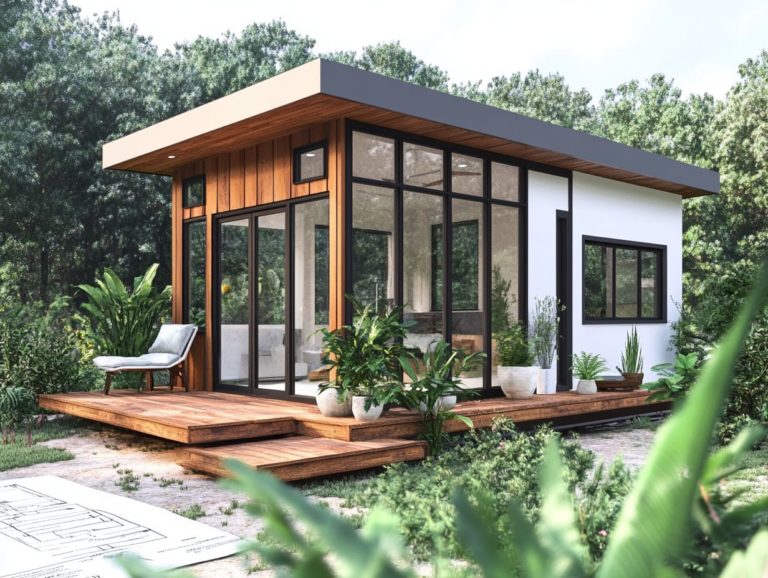Tiny House Occupancy Permits: A Guide
Tiny houses have truly captivated the world, presenting a minimalist lifestyle that champions simplicity and sustainability.
So, what exactly qualifies as a tiny house, and what variations are out there? Beyond their charming design, living in a tiny house offers a wealth of benefits think financial savings, a reduced environmental footprint, and a more purposeful way of life.
Navigating the legal maze for occupancy permits can feel overwhelming. This guide will walk you through the essentials, from demystifying the application process to tackling common hurdles and exploring alternative living options.
Whether you’re merely intrigued by the idea of tiny house living or you’re poised to take that leap, this article is designed to equip you with everything you need to know.
Contents [hide]
- Key Takeaways:
- What are Tiny Houses?
- Benefits of Living in a Tiny House
- Obtaining an Occupancy Permit for a Tiny House
- Requirements for Obtaining an Occupancy Permit
- Challenges in Obtaining an Occupancy Permit
- Alternative Options for Tiny House Living
- Frequently Asked Questions
- What is a tiny house occupancy permit?
- Do all tiny houses require an occupancy permit?
- What are the requirements for obtaining a tiny house occupancy permit?
- Can I live in a tiny house on wheels with an occupancy permit?
- What are the benefits of obtaining a tiny house occupancy permit?
- How long does a tiny house occupancy permit last?
Key Takeaways:

- Tiny houses offer financial, environmental, and lifestyle benefits that make them a popular housing option.
- Obtaining an occupancy permit for a tiny house involves understanding the legal process and meeting zoning laws, safety, and building code requirements.
- Overcoming common challenges and exploring alternative living arrangements can make tiny house occupancy permits a viable option for those seeking a simpler lifestyle.
What are Tiny Houses?
Tiny houses represent a sophisticated approach to compact living, seamlessly blending efficiency with a commitment to minimalism and sustainability, typically ranging from 100 to 400 square feet.
In Kentucky, you’ll find that the rising trend of tiny home living is transforming the housing market. It presents affordable options that cater to diverse lifestyles. These homes not only adhere to tiny home regulations but also foster a sense of community, providing solutions for those looking to downsize or embrace a more sustainable way of life. For those considering this lifestyle, exploring tiny house residency legal insights can be invaluable.
Definition and Types
A tiny house is typically considered a residential structure that is remarkably smaller than a conventional home, usually measuring under 400 square feet.
You ll find that these compact living spaces can be divided into two main categories: mobile tiny homes, which are often built on trailers for effortless relocation, and stationary tiny homes, which rest on permanent foundations.
Each type brings its own unique set of regulations, shaped by local government zoning codes, which are rules that determine where you can place your tiny house. For instance, tiny house residency laws you should know can significantly impact your decisions. Mobile tiny homes might require different permits and face distinct restrictions compared to stationary ones, compelling potential owners like you to navigate a complicated web of construction permits and safety compliance measures.
Grasping these distinctions is essential, as they can greatly influence where you can establish your home and how you align with municipal standards.
Benefits of Living in a Tiny House
Living in a tiny house presents a wealth of advantages that cater to a variety of individuals. You’ll discover financial savings, environmental benefits, and a simplified lifestyle that make this choice increasingly appealing in today s housing market.
Tiny living is incredibly exciting for those wanting to embrace a new lifestyle!
Financial, Environmental, and Lifestyle Benefits
The financial advantages of living in a tiny house are compelling. You ll enjoy lower mortgage payments and reduced utility costs.
By choosing a tiny house, you can drastically cut your mortgage payments, often bringing them in under $100,000. The average mortgage for a traditional home can soar past $300,000. This cut in costs makes it easier to save money or take trips.
With smaller living spaces, you stand to slash utility bills by as much as 50%, as the heating and cooling demands are far less taxing.
Maintenance costs dwindle as well; with fewer square feet to manage, you’ll find yourself dealing with less upkeep and fewer repairs. Tiny houses also promote eco-friendly living, utilizing sustainable materials and supporting minimalism perfectly aligning with values of affordability and simplicity. If you’re considering tiny house ownership, it’s beneficial to be aware of legal tips for newbies, all while contributing positively to environmental conservation.
Obtaining an Occupancy Permit for a Tiny House

Understanding the legal process for obtaining an occupancy permit for a tiny house is crucial. This process varies based on local government regulations and adherence to the International Residential Code, which outlines safety standards for home construction. Knowing these details will help you navigate the process effectively.
Understanding the Legal Process
Obtaining an occupancy permit for your tiny house typically involves navigating local zoning codes and ensuring compliance with construction standards.
To secure this permit, it’s essential to understand the specifics of counties in Kentucky. Zoning regulations can differ significantly. For example, Jefferson County may have stricter requirements regarding minimum lot sizes and utilities, while Wolfe County might offer more lenient options for tiny dwellings. For those considering tiny homes, it’s crucial to explore tiny house ownership legal rights.
You also need to meet safety standards, which often involve inspections for plumbing and electrical installations. Submitting detailed documentation, such as property surveys and environmental assessments, is vital and can help expedite your approval, especially when considering tiny house zoning regulations.
Requirements for Obtaining an Occupancy Permit
Getting an occupancy permit for your tiny house involves understanding zoning, safety, and building codes. These regulations can vary significantly depending on your specific locality in Kentucky, so it s important to familiarize yourself with the criteria in your area.
Zoning, Safety, and Building Codes
Understanding zoning codes is essential for tiny house homeowners, as they dictate where homes can be legally placed and the safety standards to follow.
Navigating these regulations can feel overwhelming, but don’t let that stop you! Different municipalities have unique requirements that impact your ability to park or build your tiny house. For a comprehensive overview, check out tiny house regulations: a state-by-state guide. Some areas might restrict dwelling units on certain lots or impose size limitations that could hinder your minimalist lifestyle.
Safety regulations require your tiny home to comply with specific building codes, including the International Residential Code (IRC). This code outlines critical safety features such as fire exits, structural integrity, and plumbing standards.
When you comply with these codes, you can enjoy your tiny living space safely and comfortably, knowing that essential safeguards are in place to protect you from potential hazards.
Challenges in Obtaining an Occupancy Permit
While tiny house living is appealing, securing an occupancy permit often presents a variety of challenges that you must adeptly navigate.
Common Hurdles and How to Overcome Them

Common hurdles in obtaining an occupancy permit for a tiny house include vague zoning regulations, a lack of understanding of local government policies, and restrictive building codes.
While these challenges can feel daunting, there are proactive steps you can take. One effective approach is to seek help from local housing advocates who understand the specific regulations, including tiny house parking legal guidelines, and can provide tailored guidance for your situation. Engaging directly with the building department can also clarify doubts and improve your understanding of compliance requirements.
In Kentucky, there have been inspiring successes. For instance, in Jefferson County, community networks have advocated for more flexible tiny house regulations, resulting in actual policy changes. By leveraging these resources, you can make informed decisions and explore tiny house zoning issues solutions to advocate for more accommodating guidelines in your area.
Alternative Options for Tiny House Living
For those considering housing options beyond conventional homeownership, alternative arrangements for tiny house living offer innovative solutions tailored to various needs and preferences.
Exploring Different Living Arrangements
Exploring different living arrangements for tiny houses, such as tiny house communities and co-housing options, reveals a wealth of unique benefits that foster a strong sense of community among residents.
These arrangements encourage meaningful interactions. They also support sustainability by sharing resources. You can take advantage of communal spaces like gardens and recreational areas, which enhance social connections and facilitate a more vibrant lifestyle. Additionally, understanding tiny house ownership from a legal perspective can be crucial for maximizing these benefits.
Co-housing options often embrace cooperative models, meaning that you share tools and appliances. This helps to significantly reduce personal expenses while minimizing your environmental footprint. This lifestyle beautifully aligns with the principles of minimalism and intentional living, allowing you to prioritize relationships and experiences over material possessions. To fully enjoy this lifestyle, it’s important to be aware of any local laws; check out these tips for understanding tiny house regulations.
By embracing these alternatives, you can cultivate a supportive network that ultimately enriches your living experience. Imagine living in a cozy community where every neighbor is a friend!
Frequently Asked Questions
What is a tiny house occupancy permit?
A tiny house occupancy permit is a legal document issued by a local government that allows a tiny house to be occupied as a residence.
Do all tiny houses require an occupancy permit?

Yes, most jurisdictions require permission to live in a tiny house for any type of permanent residence, including tiny houses.
What are the requirements for obtaining a tiny house occupancy permit?
The requirements vary depending on the location, but generally include compliance with building codes, zoning regulations, and health and safety standards.
Can I live in a tiny house on wheels with an occupancy permit?
It depends on the local regulations. Some jurisdictions allow it, while others may have restrictions on where and for how long a tiny house on wheels can be parked.
What are the benefits of obtaining a tiny house occupancy permit?
Obtaining an occupancy permit ensures that your tiny house is built to code and is safe for occupancy. It also allows you to legally live in your tiny house without the risk of fines or eviction.
How long does a tiny house occupancy permit last?
The duration of an occupancy permit varies by location, but typically ranges from 1-3 years. Some jurisdictions may require periodic renewal.
Start your journey towards community living today! Explore local tiny house communities!






